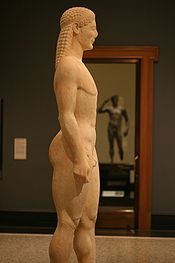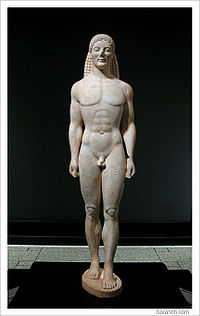
Getty kouros
Encyclopedia

Statue
A statue is a sculpture in the round representing a person or persons, an animal, an idea or an event, normally full-length, as opposed to a bust, and at least close to life-size, or larger...
in the form of a late archaic Greek kouros
Kouros
A kouros is the modern term given to those representations of male youths which first appear in the Archaic period in Greece. The term kouros, meaning youth, was first proposed for what were previously thought to be depictions of Apollo by V. I...
. The dolomitic
Dolomite
Dolomite is a carbonate mineral composed of calcium magnesium carbonate CaMg2. The term is also used to describe the sedimentary carbonate rock dolostone....
marble
Marble
Marble is a metamorphic rock composed of recrystallized carbonate minerals, most commonly calcite or dolomite.Geologists use the term "marble" to refer to metamorphosed limestone; however stonemasons use the term more broadly to encompass unmetamorphosed limestone.Marble is commonly used for...
sculpture was bought by the J. Paul Getty Museum
J. Paul Getty Museum
The J. Paul Getty Museum, a program of the J. Paul Getty Trust, is an art museum. It has two locations, one at the Getty Center in Los Angeles, California, and one at the Getty Villa in Pacific Palisades, Los Angeles, California...
, Malibu, California, in 1985 for $7 million and first exhibited there in October 1986.
Despite initial favourable scientific analysis of the patina and aging of the marble, the question of its authenticity
Authenticity in art
Authenticity in art has a variety of meanings related to different ways in which a work of art or an artistic performance may be considered authentic.Denis Dutton distinguishes between nominal authenticity and expressive authenticity....
has persisted from the beginning. Subsequent demonstration of an artificial means of creating the de-dolomitization observed on the stone has prompted a number of art historians to revise their opinions of the work. If genuine, it is one of only twelve complete kouroi still extant. If fake, it exhibits a high degree of technical and artistic sophistication by an as-yet unidentified forger
Art forgery
Art forgery is the creation of works of art which are falsely attributed to other, usually more famous, artists. Art forgery can be extremely lucrative, but modern dating and analysis techniques have made the identification of forged artwork much simpler....
. Its status remains undetermined: today the museum's label
Museum label
A museum label or caption is a label describing an object exhibited in a museum, or one introducing a room or area, or the whole museum.-Introduction labels:...
reads "Greek, about 530 B.C., or modern forgery".
Provenance
The kouros first appeared on the art market in 1983 when the BaselBasel
Basel or Basle In the national languages of Switzerland the city is also known as Bâle , Basilea and Basilea is Switzerland's third most populous city with about 166,000 inhabitants. Located where the Swiss, French and German borders meet, Basel also has suburbs in France and Germany...
dealer Gianfranco Becchina offered the work to the Getty's curator of antiquities, Jiri Frel. Frel deposited the sculpture (then in seven pieces) at Malibu along with a number of documents purporting to attest to the statue’s authenticity. These documents traced the provenance of the piece to a collection in Geneva
Geneva
Geneva In the national languages of Switzerland the city is known as Genf , Ginevra and Genevra is the second-most-populous city in Switzerland and is the most populous city of Romandie, the French-speaking part of Switzerland...
of Dr. Jean Lauffenberger who, it was claimed, had bought it in 1930 from a Greek dealer. No find site or archaeological data was recorded. Amongst the papers was a suspect 1952 letter allegedly from Ernst Langlotz, then the preeminent scholar of Greek sculpture, remarking on the similarity of the kouros to the Anavyssos youth
Kroisos Kouros
The Kroisos Kouros is a marble kouros from Anavyssos in Attica which functioned as a grave marker for a fallen young warrior named Kroísos. The free-standing sculpture strides forward with the "archaic smile" playing slightly on his face. The sculpture is dated to c. 540-515 BC and stands 1.95...
in Athens (NAMA 3851). Later inquiries by the Getty revealed that the postcode on the Langlotz letter did not exist until 1972, and that a bank account mentioned in a 1955 letter to an A.E. Bigenwald regarding repairs on the statue was not opened until 1963. The documentary history of the sculpture was evidently an elaborate hoax and therefore there are no reliable facts about its recent history before 1983.
Stylistic analysis
The Getty kouros is highly eclectic in style. Our understanding of the development of kouroi as delineated by Gisela Richter suggests the date of the Getty youth diminishes from head to feet. Beginning with the hair we can observe that it is braided into a wig-like mass of 14 strands each of which ends in a triangular point. The closest parallel here is to the Sounion kouros (NAMA 2720) of the late 7th century/early 6th century, which also displays 14 braids, as does the New York kouros (NY Met. 32.11.1). However, the Getty kouros’s hair exhibits a rigidity very unlike the Sounion Group. Descending to the hands we may see that the last joints of the fingers turn in at right angles to the thighs, recalling the Tenea kourosKouros of Tenea
The grave statue of a youth from Tenea known as the Kouros of Tenea is now located in the Glyptothek in Munich, Germany....
(Munich 168) of the 2nd quarter of the 6th century. Further down, a late archaic naturalism becomes more pronounced in the rendering of the feet similar to kouros No. 12 from the Ptoon sanctuary (Thebes 3), as is the broad oval plinth which in turn is comparable to a base found on the Acropolis. Both Ptoon 12 and the Acropolis base are assigned to the Group of Anavyssos-Ptoon 12 and dated to the third quarter of the 6th century. Anachronizing elements are not unknown in authentic kouroi, but the disparity of up to a century is a strikingly unusual feature of the Getty sculpture.
Technical analysis


Some indication of tool marks remains on the work. Though the surface is weathered (or artificially abraded) and it is not clear if emery was used we can discern the heavy claw marks on the plinth and the use of a point in some of the finer detailing. For example there are point marks in the outline of the curls, between the fingers and in the cleft of the buttocks, also traces of the point in the arches of the feet and at random over the plinth. Though the tools evident here (fine point, slope chisel, claw chisel) are not inappropriate for a late 6th century sculpture their application might be problematic. Stelios Triantis remarks, "no sculptor of kouroi would hollow out with a fine point, nor incise outlines with this tool".
In 1990, Dr. Jeffery Spier published the discovery of a kouros torso, a certain forgery that exhibited notable technical similarities to the Getty kouros. After samples were taken that determined the fake torso was of the same dolomitic marble as the Getty piece the torso was purchased by the museum for study purposes. The fake’s sloping shoulders and upper arms, volume of chest, rendering of the hands and genitals all suggest the same hand as the Getty’s example, although the aging had been crudely done with an acid bath and the application of iron oxide. Further investigation has shown the torso and the kouros are not from the same block and the sculpting techniques are dramatically different (down to the use of power tools on the torso). Their relationship if any is still to be determined.
Archaeometry
The Getty commissioned two scientific studies on which it based its decision to buy the statue. The first was by Norman Herz, a professor of geology at the University of GeorgiaUniversity of Georgia
The University of Georgia is a public research university located in Athens, Georgia, United States. Founded in 1785, it is the oldest and largest of the state's institutions of higher learning and is one of multiple schools to claim the title of the oldest public university in the United States...
, who measured the carbon and oxygen isotope ratios, and traced the stone to the island of Thasos. The marble was found to have a composition of 88% dolomite and 12% calcite, by x-ray diffraction. His isotropic analysis revealed that δ18O = -2.37 and δ13C = +2.88, which from database comparison admitted one of five possible sources: Denizli, Doliana, Marmara, Mylasa, or Thasos-Acropolis. Further, trace element analysis of the kouros eliminated Denizli. With the high dolomite content Thasos was determined to be the likeliest source with a 90% probability. The second test was by Stanley Margolis, a geology professor at the University of California
University of California
The University of California is a public university system in the U.S. state of California. Under the California Master Plan for Higher Education, the University of California is a part of the state's three-tier public higher education system, which also includes the California State University...
at Davis. He showed that the dolomite surface of the sculpture had undergone a process called de-dolomitization, in which the magnesium content had been leached out, leaving a crust of calcite, along with other minerals. Margolis determined that this process could occur only over the course of many centuries and under natural conditions, and therefore could not be duplicated by a forger.
In the early 1990s, the marine chemist Miriam Kastner produced an experimental result which cast doubt on Margolis’s thesis by artificially inducing de-dolomitization in the laboratory, a result since confirmed by Margolis. However, although this does admit the possibility the kouros was synthetically aged by a forger the procedure is a complicated and time-consuming one. The unlikeliness of a forger using such experimental methods in what is still an uncertain science has prompted the Getty’s antiquities conservator to remark "when you consider a forger actually repeating the procedure you begin to leave the realm of practicality”.
Sources
- Robert Bianchi, Saga of The Getty Kouros, Archaeology (May/June 1994).
- Jerry Podany, Et Al., A Sixth Century B.C. Kouros in the J. Paul Getty Museum, J. Paul Getty Museum, 1992.
- Angeliki Kokkou (ed.), The Getty Kouros Colloquium: Athens, 25-27 May 1992, J. Paul Getty Museum, 1993.
- Norman Herz, Marc Waelkens, Classical Marble: Geochemistry, Technology, Trade, North Atlantic Treaty Organization Scientific Affairs Division, 1988.
- Jeffrey Spier, Blinded by Science: The Abuse of Science in the Detection of False Antiquities, The Burlington Magazine, Vol. 132, No. 1050 (Sep., 1990), pp. 623-631.
- Marion True, A Kouros at the Getty Museum, The Burlington Magazine, Vol. 129, No. 1006 (Jan., 1987), pp. 3-11.

